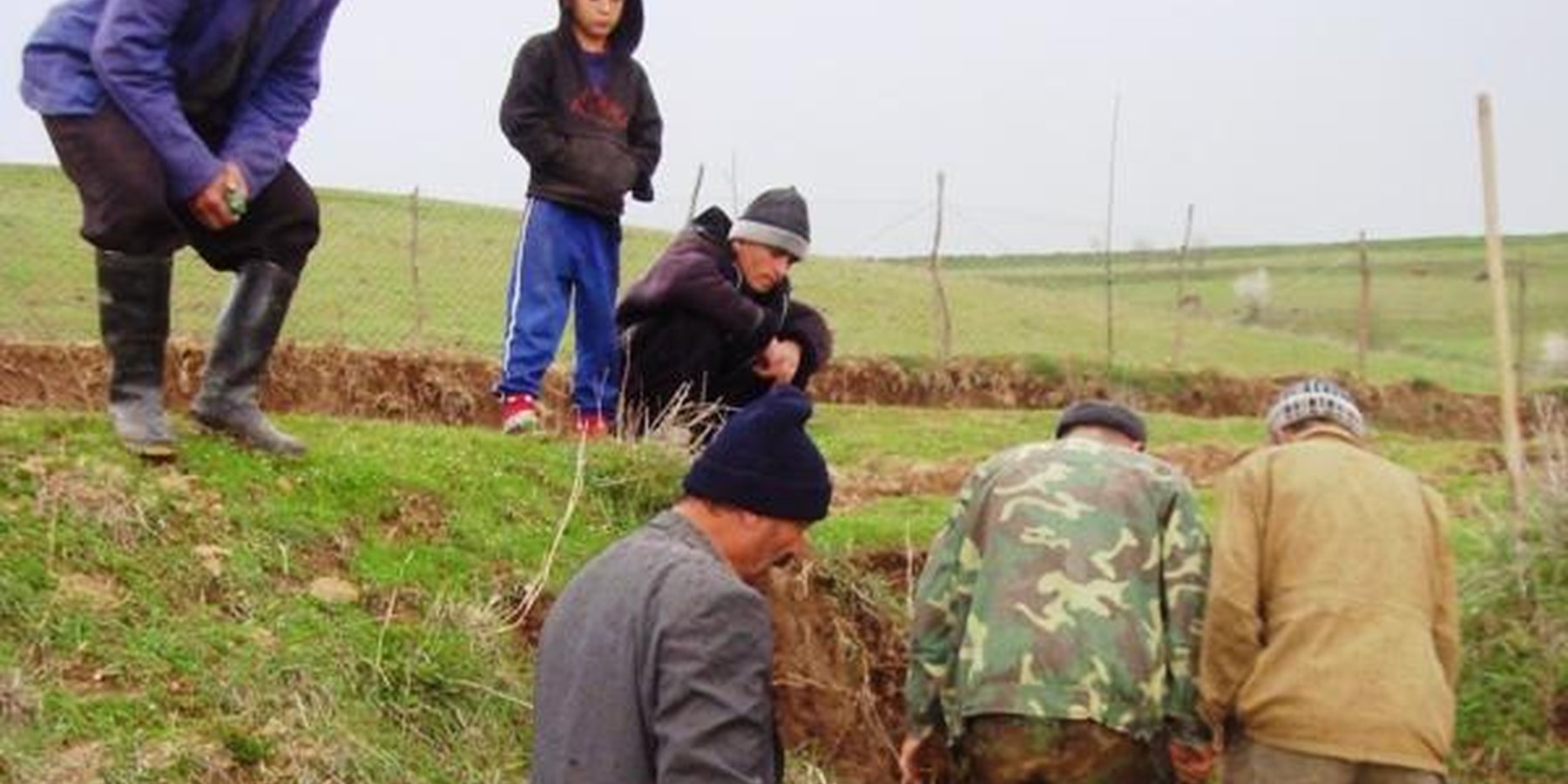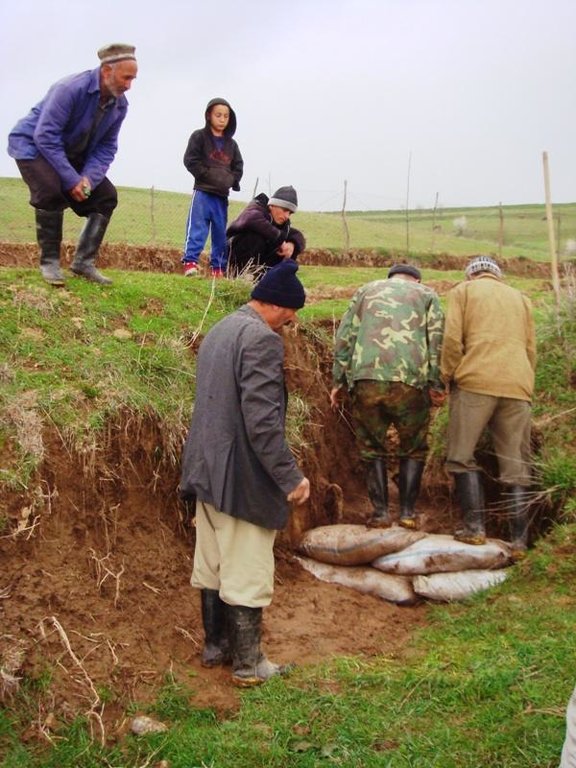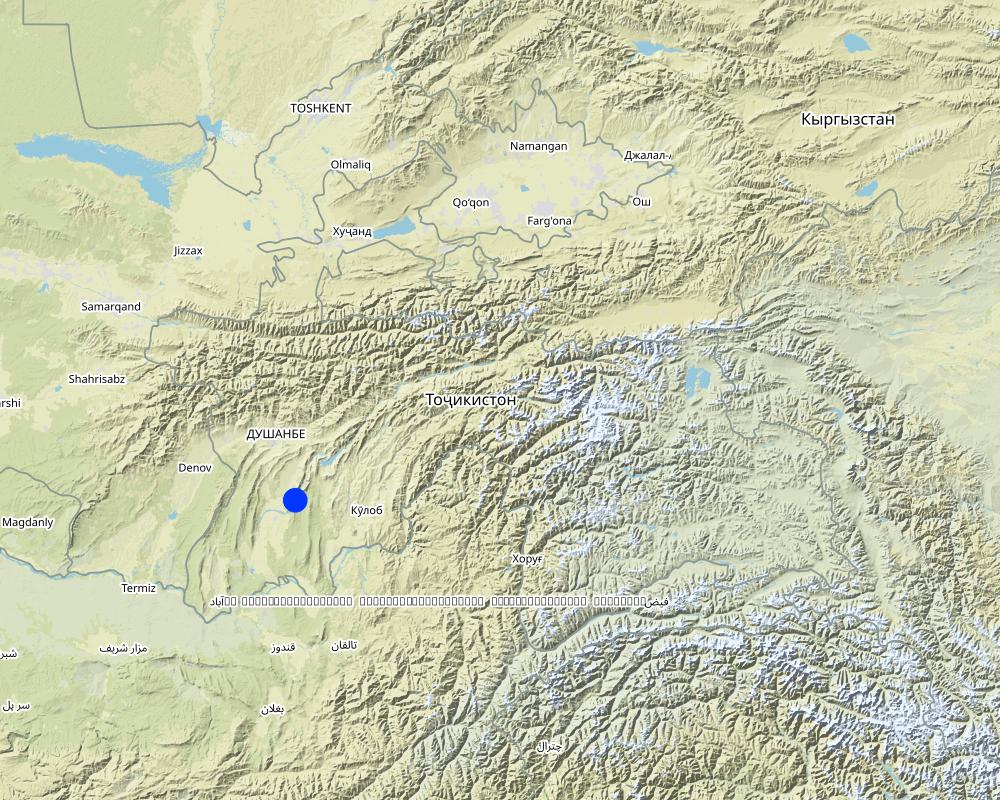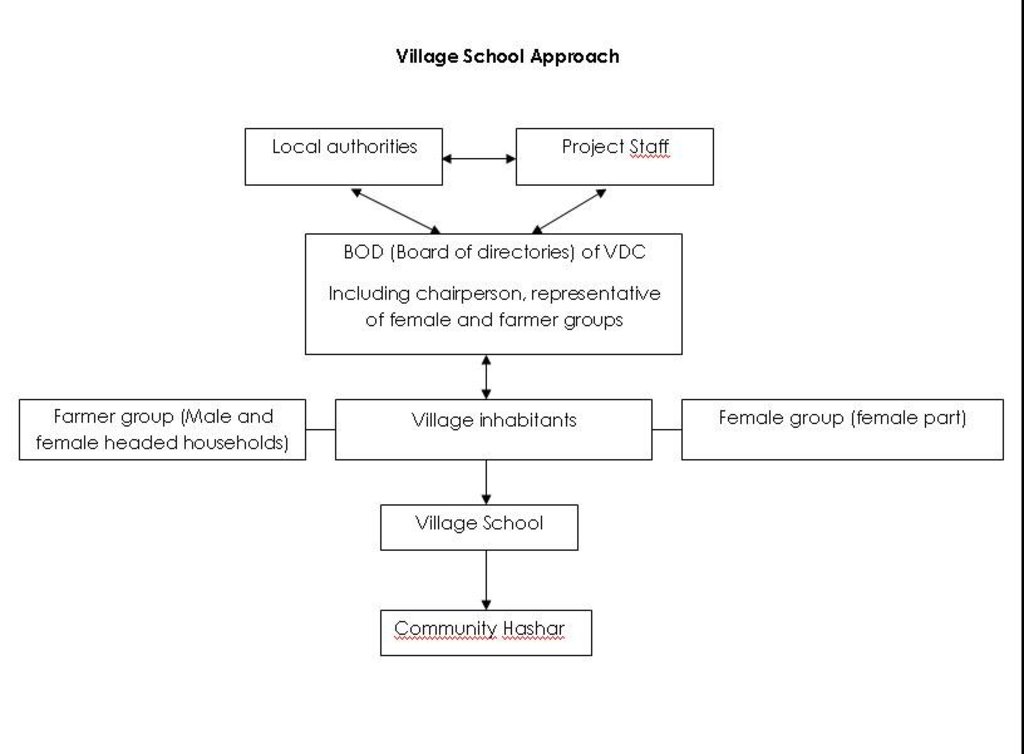Village school participation and involvement [塔吉克斯坦]
- 创建:
- 更新:
- 编制者: Daler Domullojonov
- 编辑者: –
- 审查者: David Streiff, Alexandra Gavilano, Joana Eichenberger
Чалб ва иштироки мактаби деха
approaches_2572 - 塔吉克斯坦
查看章节
全部展开 全部收起1. 一般信息
1.2 参与方法评估和文件编制的资源人员和机构的联系方式
有助于对方法进行记录/评估的项目名称(如相关)
Pilot Program for Climate Resilience, Tajikistan (WB / PPCR)有助于对方法进行记录/评估的机构名称(如相关)
Deutsche Welthungerhilfe e. V. (Welthungerhilfe) - 塔吉克斯坦1.3 关于使用通过WOCAT记录的数据的条件
编制者和关键资源人员接受有关使用通过WOCAT记录数据的条件。:
是
2. SLM方法的描述
2.1 该方法的简要说明
A competitive tendering process for project grant money to implement identified SLM practices within a community, and on completion of the implementation activities the village school will be assigned ownership and responsibility for the maintenance and sustainability.
2.2 该方法的详细说明
该方法的详细说明:
Aims / objectives: The objective of the approach is to find a mechanism by which you can involve large sections of the community, allocate land for the communities benefit, provide a mechanism for long term maintenance, and establish a demonstration area for cross site visits and educational training.
Methods: Several methods were employed to implement the approach, these included community and local government workshops, seminars on proposal writing followed by subsequent proposal development in conjunction with local experts and community mobilization. The project staff used the approach to train active community members on suitable land management practices that would benefit identified degraded lands and develop sustainable competitive proposals to be reviewed by a selection panel. The community was encouraged to provide substantial input into the funding of their proposed project if they wanted to be successful. A predetermined condition was set on awarded grants that the degraded land had to be officially allocated to the school for a twenty year period.
Stages of implementation: The INGO Welthungerhilfe announced a competition amongst the local communities in one region to submit project proposals for addressing community environmental problems. The local government were involved from the outset, were encouraged to help suggest communities that should compete. The communities were provided with workshops on how to develop sustainable land management proposals with support from local agronomists. The proposals had to outline the commitment of the community, the area of land to be re-established and how, and finally the level of community contribution towards the project. The terms of the competition dictated that the area of rejuvenated land would be officially signed over to the school for a period of twenty year and the school community would thereby be responsible for the maintenance and upkeep of the land and entitled to invest any profits back into the school, hence indirectly supporting many families in the community. The projects were selected based on a predetermined criterion and the winning projects received part funding in the form of fuel, machinery, fencing etc upto 50% of the final costs. The people were mobilised to implement the project though a community day of action know as a ‘Hashar’ and on completion the school assumed responsibility for the plot of land.
Role of stakeholders: Although the approach is project driven it required buy in from the local authorities, and the heads of collective dehkan farms who dedicate land use right to village schools, however it was the school community that had to be the real driving force to see the proposal developed into a tangible outcome.
2.3 该方法的照片
2.5 采用该方法的国家/地区/地点
国家:
塔吉克斯坦
区域/州/省:
Tajikistan / Khatlon
有关地点的进一步说明:
Khovaling / Dorobi
Map
×2.6 该方法的开始和终止日期
注明开始年份:
2
终止年份(若不再采用该方法):
2009
2.7 方法的类型
- 基于项目/方案
2.8 该方法的主要目的/目标
The Approach focused mainly on SLM with other activities (Community initiated SWC activities realised with involvement of village school, holistic approach, )
environmental restoration by community involvement. to prevent soil erosion, gulley expansion and land degradation; to convert barren land to agroforestry system. to create capacity of villagers and young generation to protect environment and effective use of locally available natural resources.
The SLM Approach addressed the following problems: Poor land management practices compounded by a lack of knowledge and funds that have resulted in continued land degradation and loss of fertility.
2.9 推动或妨碍实施本办法所适用的技术的条件
财务资源和服务的可用性/可得性
- 阻碍
Limited availability of funds
Treatment through the SLM Approach: Project provided support funding to match contributions provided by the community.
法律框架(土地使用权、土地和水使用权)
- 启动
The existing land ownership, land use rights / water rights greatly helped the approach implementation: The state were very supportive of the allocation of land to the schools.
- 阻碍
There were no formal documented land user rights on the land selected for the implementation of technologies.
Treatment through the SLM Approach: Before the implementation started the plot of land was officially assigned to the school for a period of 20 years.
了解SLM,获得技术支持
- 阻碍
There is a lack of technical knowledge within the community.
Treatment through the SLM Approach: A series of cross visits and practical trainings were organised by the project to neighboring communities.
工作量、人力资源可用性
- 阻碍
There is extensive work required in the successful implementation and maintenance of the chosen technologies.
Treatment through the SLM Approach: The plot was divided into 3 parts to assign specific responsibilities.
3. 相关利益相关者的参与和角色
3.1 该方法涉及的利益相关者及其职责
- 当地土地使用者/当地社区
Community members and farmers
Mainly heavy activities like organic fertilizers carry, ploughing and planting was carried by males.
Women supported with feeding of workers.
All interested community members were involved in all stages of activities implementation and final beneficiary of action is school.
- SLM专家/农业顾问
The approach was designed by international experts with input from national specialists
Project technical staff, advisor
- 教师/学龄儿童/学生
School teacher
- NGO
WHH project staff
- 地方政府
Head of jamoat (sub district), and village head
如果涉及多个利益相关者,请注明领导机构:
local authorities and project staff
3.2 当地土地使用者/当地社区参与该方法的不同阶段
| 当地土地使用者/当地社区的参与 | 指定参与人员并描述活动 | |
|---|---|---|
| 启动/动机 | 自我动员 | community members leading by teacher presented project proposal to receive support of project realization to WHH project |
| 计划 | 互动 | teachers together with project staff look through and updated plan |
| 实施 | 互动 | in the beginning it was really good and active labor and in-kind contribution of activity, once additionally in cash contribution was required teacher continued alone |
| 监测/评估 | 外部支持 | joint (project staff and villagers) monitoring of activities were realized during activities implementation and finalizing |
| Research | 无 |
3.3 流程图(如可用)
具体说明:
The organisational set up instigated by the project staff with the involvement of the local authorities resulting in a community day of action for implementation of the technologies
作者:
Daler Domullojonov (WHH, Dushanbe)
3.4 有关SLM技术选择的决策
具体说明谁有权决定选择要实施的技术:
- 主要是SLM专家,咨询土地使用者之后
解释:
The idea was discussed in meeting with villagers, local authorities representatives and project staff.
Decisions on the method of implementing the SLM Technology were made by mainly by SLM specialists with consultation of land users. In the joint meetings low cost measures were chosen and cost sharing discussed with the community members.
4. 技术支持、能力建设和知识管理
4.1 能力建设/培训
是否为土地使用者/其他利益相关者提供培训?:
是
明确受训人员:
- 土地使用者
- 现场工作人员/顾问
如果相关,请说明性别、年龄、地位、种族等。:
To approach provided training on proposal writing and during the technology implementation stage on basic soil c conservation techniques.
培训形式:
- 在职
- 农民对农民
- 示范区域
- 公开会议
涵盖的主题:
Proposal writing, soil conservation techniques and cross site visits.
4.2 咨询服务
土地使用者有权使用咨询服务吗?:
是
指明是否提供了咨询服务:
- 在土地使用者的土地上
说明/注释:
Advisory service is quite adequate to ensure the continuation of land conservation activities; heads of jamoat (sub district), collective dehkan farm and village
4.3 机构强化(组织发展)
是否通过这种方法建立或加强了机构?:
- 否
4.4 监测和评估
监测和评估是该方法的一部分吗?:
是
注释:
area treated aspects were regular monitored by project staff through observations; indicators: covered area
no. of land users involved aspects were ad hoc monitored by land users through observations; indicators: progress of used technics
technical aspects were regular monitored by land users through observations; indicators: None
management of Approach aspects were ad hoc monitored by project staff through observations; indicators: None
There were no changes in the Approach as a result of monitoring and evaluation: None
There were few changes in the Technology as a result of monitoring and evaluation: Check dams with plastic sacks were covered after observing short durability, The size of contour trenches were adjusted after rainy season, additionally to rain water harvesting pounds establishment of conservation pound was added upstream
4.5 研究
研究是该方法的一部分吗?
是
明确话题:
- 技术
提供进一步的细节,并指出是谁做的研究:
Research was carried out on-farm
5. 融资和外部物质支持
5.1 该方法中SLM组成部分的年度预算
如果不知道准确的年度预算,请给出一个范围:
- 2,000-10,000
注释(例如主要的资助来源/主要捐助者):
Approach costs were met by the following donors: local community / land user(s) (labour, poles for fence, seedlings of trees and shrubs, seeds of grains, rent of tractor ): 60.0%; international non-government (fencing material, fuel for earth works, part of seedlings, seeds of perennial plants): 40.0%
5.2 为土地使用者提供财政/物质支援
土地使用者是否获得实施该技术的财政/物质支持?:
是
如果是,请具体说明支持的类型、条件和提供者:
In the implementation EC TACIS financed the Welthungerhilfe project support in form of materials and seeds
5.3 对特定投入的补贴(包括劳动力)
- 农业
| 具体说明哪些投入得到了补贴 | 程度如何 | 对补贴做出具体说明 |
|---|---|---|
| 种子 | 部分融资 | |
| 化肥 | 部分融资 | |
| seedlings | 部分融资 | |
- 其它
| 其它(具体说明) | 程度如何 | 对补贴做出具体说明 |
|---|---|---|
| logistics | intial discussion groups and trainings |
如果土地使用者的劳动力是一项重要的投入,那么是不是:
- 自愿
注释:
The village organised a HASHAR i.e. a community action day.
The initial discussion and training on the development of proposals was partly financed by the community.
5.4 信用
是否根据SLM活动的方法给予信用值?:
否
6. 影响分析和结论性陈述
6.1 方法的影响
该方法是否帮助土地使用者实施和维护SLM技术?:
- 否
- 是,很少
- 是,中等
- 是,支持力度很大
First of all the approach was discussed with all community members.
该方法是否有助于社会和经济弱势群体?:
- 否
- 是,很少
- 是,中等
- 是,支持力度很大
The project was focused on providing for the communitz schools.
该方法是否改善了阻碍SLM技术实施的土地使用权/用户权问题?:
- 否
- 是,很少
- 是,中等
- 是,支持力度很大
The problem is unlikely to be overcome in the near future.
Did other land users / projects adopt the Approach?
- 否
- 是,很少
- 是,中等
- 是,支持力度很大
The approach was implemented in another 15 communities.
Did the Approach lead to improved livelihoods / human well-being?
- 否
- 是,很少
- 是,中等
- 是,支持力度很大
It was good example of integration low cost soil and water conservation measures to restore existing problems instead of complaining about lack of funds and extra support.
Did the Approach help to alleviate poverty?
- 否
- 是,很少
- 是,中等
- 是,支持力度很大
non productive land was converted to agro forest, and for the future a well managed orchard can provide substantial support to the school.
6.2 土地使用者实施SLM的主要动机
- 增加利润(能力),提高成本效益比
to convert non profitable land to orchard
- 支付/补贴
to get support for address environmental problem
- 声望、社会压力/社会凝聚
can be proud of their achievements among other schools
- well-being and livelihoods improvement
to support school
6.3 方法活动的可持续性
土地使用者能否维持通过该方法实施的措施(无外部支持的情况下)?:
- 不确定
若否或不确定,请具体说明并予以注释:
The approach was project driven and provided subsidises therefore it may be difficult for the communities to replicate without external sources of finance.
6.4 该方法的长处/优点
| 土地使用者眼中的长处/优势/机会 |
|---|
| Additional income source for school budget. (How to sustain/ enhance this strength: Pupils could be taught how to optimise the use of the land.) |
| Improvement in the quality of land and has reduced the risk from natural disasters. (How to sustain/ enhance this strength: The technologies could be adapted as the land improves in the future.) |
| 编制者或其他关键资源人员认为的长处/优势/机会 |
|---|
| A major problem was to connect the land tenure with the final beneficiaries within the community. This issue was solved through handing over all rights to village school. (How to sustain/ enhance this strength: The approach may benefit from the involvement of legal land specialist.) |
| It is a low cost, holistic, approach involving all community through village school. (How to sustain/ enhance this strength: It could be further enhanced with extra support of local authorities) |
| The approach provides a source of income for the school and provides a place of learning for the children. (How to sustain/ enhance this strength: Further sites with different SLM practices coul dbe developed into school demonstration plots.) |
6.5 该方法的弱点/缺点以及克服它们的方法
| 土地使用者认为的弱点/缺点/风险 | 如何克服它们? |
|---|---|
| It required continuously cultivation activities in the beginning. The community became tired of volunteering after several days. | Responsible person /s has to be in charge to mobilise the people |
| 编制者或其他关键资源人员认为的弱点/缺点/风险 | 如何克服它们? |
|---|---|
| In the beginning the school did not benefit too much. | Additional crops can be planted |
7. 参考和链接
7.1 方法/信息来源
- 实地考察、实地调查
- 与土地使用者的访谈
7.2 参考可用出版物
标题、作者、年份、ISBN:
Final narrative report of EC Contract # 144-912
可以从哪里获得?成本如何?
Welthungerhilfe project in Temurmalik district
链接和模块
全部展开 全部收起链接
无链接
模块
无模块





